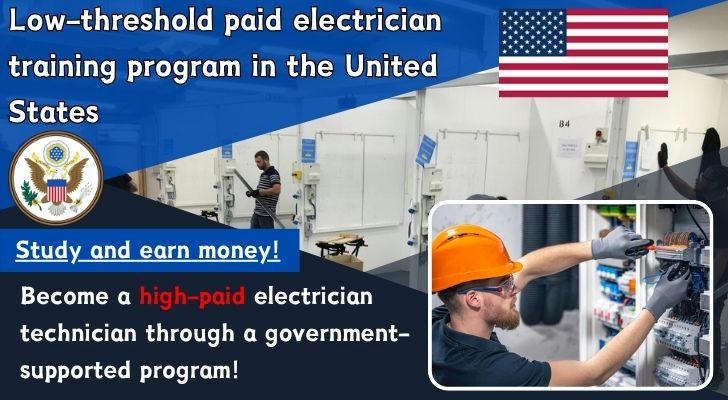Get Paid to Learn! Electrician Training in the U.S. - Government-Support, No Experience Necessary, Starting at $22/Hour
Kickstart a high-paying career as an electrician—no prior experience needed! Programs like those offered by Cummings Electrical and the IBEW (International Brotherhood of Electrical Workers) combine paid on-the-job training with classroom instruction, Apprentice wages start at $22/hour and increase based on learning and experience. Through government-backed programs and partnerships with employers, apprentices can earn an income while learning a skill. This article outlines the certification pathway to secure, well-paying work in the electrical industry.

Why Choose Electrician Training with an Apprenticeship Scheme (Government Support)?
1️⃣ Earn While You Learn: Apprentices start at $22/hour, with wages increasing as skills advance (U.S. Bureau of Labor Statistics, 2024).
2️⃣ Zero Experience Required: Programs prioritize hands-on training; beginners welcome.
3️⃣ Nationwide Certification: Graduates receive credentials recognized by the Department of Labor.
4️⃣ High Demand: Electrical jobs grow 11% annually (BLS), with median pay at $60,040/year. Electrical jobs are grow 11% annually (BLS), with median pay at $60,040/year. With more experience, the average annual salary is $84,000/year. 5️⃣ Employer Partnerships: Some companies cover the cost of training under an apprenticeship agreement.
What Government-Supported Electrician Training Programs Are Available?
1️⃣ Cummings Electrical Apprenticeship
- Paid Training:Provides a government-supported apprenticeship training program that combines classroom learning with practical experience. Salaries increase with experience, with an average salary of $32.60/hour.
- Duration: 4-year program (6,000 hours OTJ + 500 classroom hours).
- Location: Texas, Colorado Springs (employer-sponsored slots available).
2️⃣ WIOA (Workforce Innovation and Opportunity Act) Support
- Government Subsidies: WIOA-funded programs offer financial assistance to cover training costs, reducing the financial burden on participants.
- Flexible Learning Options: These programs often include online or hybrid learning to accommodate different schedules.
- Employment Services: WIOA provides job placement support, helping graduates secure employment in the electrical field.
3️⃣ Community College Partnerships
- Hybrid Learning: Evenings/weekend classes + local employer placements.
- WIOA Eligible: Dislocated workers access subsidies for tools/books.
- Job Guarantee: 92% placement rate post-certification.
Other Project Options
In addition to government-supported programs, non-profit organizations and private institutions also offer paid electrician training opportunities. For example,partners with local organizations to provide apprenticeship plans tailored to individuals with varying backgrounds.
How Do I Apply for the Electrician Training Apprenticeship Program?
Basic Qualifications:
- Age 18+ with high school diploma/GED.
- Pass basic math/aptitude tests (no trade knowledge required).
- Physical ability to handle tools/lift 50 lbs.
Application Steps:
1️⃣ Research Programs:Use the [Apprenticeship Finder] to find government-supported electrician training. 2️⃣ Submit Documents: Transcripts, ID, and (if applicable) veteran/military records.
3️⃣ Interview: Selected candidates will meet with employers.
Spots fill fast—apply now to secure paid training!
Success Story: From Retail to $75K/Year as a Journeyman Electrician
James R., 29, worked retail for $12/hour before joining IBEW’s apprenticeship. After 4 years of paid training ($24→$38/hour), he earned his license and now leads commercial projects in Denver. "Best decision I ever made—zero debt and a six-figure future," he says.
Electrician Training Job Responsibilities for Apprenticeship Programs
- Install/maintain wiring under supervision.
- Troubleshoot systems using multimeters/blueprints.
- Adhere to National Electrical Code® safety standards.
Paid Electrician Training by Age Group
| Age Group | Program Length | Starting Wage | Career Outlook |
|---|---|---|---|
| 18–24 | 4–5 years | $22–$26/hour | Journeyman ($60K+) |
| 25–34 | 3–4 years* | $24–$28/hour | Foreman ($75K+) |
| 35–50 | Accelerated 2–3 years | $23–$27/hour | Inspector ($70K+) |
| 50+ | Part-time options | $21–$25/hour | Contractor ($80K+) |
| *Prior construction experience may shorten timelines. |
Start Your Government-Supported Electrician Training Career!
With employer-backed apprenticeships and rising wages, electrician training offers a direct path to financial stability. Programs like Paid Training Remove Barriers — Without the Student Debt, just paychecks and credentials. Act now: The application deadline for fall class is July 2025.

